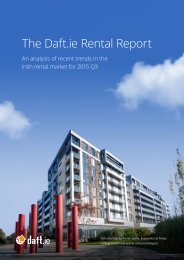The Daft.ie Rental Report
q4-daft-rental-report-2015
q4-daft-rental-report-2015
Create successful ePaper yourself
Turn your PDF publications into a flip-book with our unique Google optimized e-Paper software.
Supply of<br />
Ronan Lyons<br />
Economist at Trinity College Dublin and author<br />
of the <strong>Daft</strong>.<strong>ie</strong> <strong>Report</strong>.<br />
homes to rent<br />
must be a top priority for the<br />
next Government<br />
Three months ago,<br />
the commentary to<br />
the previous <strong>Rental</strong><br />
<strong>Report</strong> highlighted the<br />
importance of looking at<br />
quantit<strong>ie</strong>s – the number<br />
of homes available to<br />
rent – rather than prices.<br />
years. That trend has seen rents in Dublin 2 – the<br />
archetypal urban market – grow far faster than<br />
those in Leitrim, one of the cheapest rural markets.<br />
<strong>The</strong> figure below shows how average rents in<br />
Dublin 2 compare to rents in Leitrim since 2006.<br />
Ten years ago, in 2006, rents in Dublin 2 were<br />
roughly 2.8 times those in Leitrim and by 2010, that<br />
ratio had changed very little. Since then, though,<br />
Dublin 2 rents have grown so that they are now<br />
close to 3.7 times those in Leitrim.<br />
Rents in Dublin 2, relative to Leitrim<br />
3.7<br />
3.4<br />
This was in the context of calls for controls on rent<br />
increases. Blunt attempts to limit increases in rents<br />
would do nothing to address the lack of homes to<br />
rent and – like other price controls – potentially<br />
make the problem worse, rather than better, by<br />
limiting investment in new homes.<br />
How do things look three months on? With the next<br />
election just a couple of weeks away, what are the<br />
key messages the next Government should take<br />
away about the rented sector? And are the actions<br />
it needs to take?<br />
As ever, the initial focus will be on rents and how<br />
they’ve changed. <strong>The</strong>re, a clear message emerges<br />
over the last four years – the ‘urban premium’<br />
has grown and grown sharply. While Dublin rent<br />
inflation has been lower than that in the rest of the<br />
country for much of the last year, this marks only a<br />
small blip in a longer-term trend over the last five<br />
3.1<br />
2.8<br />
2.5<br />
Q1<br />
2006<br />
Q4<br />
2007<br />
Q3<br />
2009<br />
Q2<br />
2011<br />
Q1<br />
2013<br />
What does this growing urban premium mean?<br />
In most developed countr<strong>ie</strong>s, it is politically<br />
uncontroversial to say that cit<strong>ie</strong>s are where the bulk<br />
of jobs are created – and thus where population<br />
growth is centred. Ireland was, temporarily, an<br />
exception to this rule, as loose credit meant there<br />
were jobs and homes in towns, big and small.<br />
<strong>The</strong> end of the bubble, though, has refocused Irish<br />
people – young people in particular – on what kind<br />
of locations offer a good ‘labour market amenity’,<br />
i.e. jobs. <strong>The</strong> bigger the city, the better the labour<br />
market amenity and many young Irish people<br />
have decided that even Ireland’s biggest city is not<br />
big enough and gone abroad in search of safer<br />
employment prospects.<br />
Q4<br />
2014<br />
<strong>The</strong> <strong>Daft</strong>.<strong>ie</strong> <strong>Rental</strong> <strong>Report</strong> – 2015 in Rev<strong>ie</strong>w | 2



